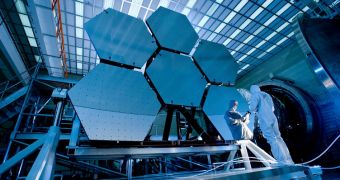As the Hubble Space Telescope is reaching the end of its life, experts at the American space agency are currently racing against the clock to develop the next generation of space observatories. Their solution to replacing the venerable orbital instrument is the James Webb Space Telescope (JWST). The planned machine, currently under construction, is to be the most complex piece of equipment ever deployed to orbit. Just recently, six of the mirror segments that will equip the JWST successfully finished a series of cryogenic tests at a NASA facility, Space Fellowship reports.
The beryllium mirror segments are incredibly sensitive and precise instruments. They have been polished until their surface became as close to being perfectly flat as possible. Any small dent can hinder the entire telescope's resolve power, and so engineers have paid special attention to its “eyes.” The recent tests the mirrors underwent took place at the NASA Marshall Space Flight Center, which is based in Huntsville, Alabama. The X-ray & Cryogenic Facility here is one of the few places in the world that can accommodate this type of investigations.
The main goal of the study was to determine how the shape of the mirror changes as the entire ensemble cools down to as low as minus 415 degrees Fahrenheit (-248 degrees Celsius). Several engineers then measured the effects of cooling the mirrors. The data will soon be sent to Redmond, California, at the Tinsely Corporation. Experts here will use the information to instruct their own teams in conducting a final polishing session on the mirror segments. After this is done, the “eyes” will be sent back to Marshall, for additional testing. An additional set of six mirrors is scheduled to arrive in Alabama soon. JWST will include 18 such segments in its final configuration.
One of the reasons why the mirrors will remain chilled to such low temperatures is the fact that it will be used to collect infrared data of the Universe. The key condition for observing hidden, cool objects and structures in the Cosmos is to observe them with objects cooler than they are. The only way to do this is by cooling the mirrors to temperatures close to absolute zero. The JWST is designed and developed by Northrop Gruman, which is under contract with the NASA Goddard Space Flight Center, in Greenbelt, Maryland.

 14 DAY TRIAL //
14 DAY TRIAL //